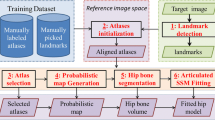Abstract
We introduce a new way to accurately segment cam-type pathological femurs from pelvic CT scans. The femur is a difficult target for segmentation due to its proximity to the acetabulum, irregular shape and the varying thickness of its hardened outer shell. In addition, the pathological femurs with femoral-acetabular impingements have a non-standard shape, which increases segmentation difficulty. We overcome these difficulties by (a) dividing the femur into two rounds of segmentation—one for the femur head and another for the body—(b) pre-processing the CT scan to reduce anatomical sources of error (c) two modes of segmentation—a rough estimation of a contour and another for fine contours. Segmentations of the CT volume are performed iteratively, on a slice-by-slice basis and contours are extracted using the morphological snake algorithm. Our methodology was designed to require little initialization from the user and to deftly handle the large variation in femur shapes, most notably from deformations attributed to cam femoral–acetabular impingements. Our efforts are to provide physicians with a new tool that creates patient-specific and high-quality 3D femur models while requiring much less time and effort. Femur models segmented with our method had an average volume overlap error of 2.71±0.44% and symmetric surface distance of 0.28±0.04 mm compared to ground truth models.
Similar content being viewed by others
References
Álvarez, L.B.-N.: A real time morphological snakes algorithm. Retrieved 6 September, 2010 from image processing on line: http://www.ipol.im/pub/algo/abmh_real_time_morphological_snakes_algorithm/ (2010)
Álvarez, L., Baumela, L., Henríquez, P., Márquez-Neila, P.: Morphological snakes. In: IEEE Conference on Computer Vision and Pattern Recognition, San Francisco (2010)
Caselles, V., Kimmel, R., Sapiro, G.: Geodesic active contours. Int. J. Comput. Vis. 22(1), 61–79 (1997)
Chan, T., Vese, L.A.: Active contours without edges. IEEE Trans. Images Process. 10(2), 266–277 (2001)
Chen, S., Radke, R.J.: Level set segmentation with both shape and intensity priors. In: IEEE 12th International Conference on Computer Vision, pp. 763–770 (2009)
Cohen, L.: On active contour models and balloons. CVGIP, Image Underst. 53(2), 211–218 (1991)
Cohen, L.D., Cohen, I.: Finite-element methods for active contour models and balloons for 2-D and 3-D images. IEEE Trans. Pattern Anal. Mach. Intell. 15(11), 1131–1147 (1993)
Cootes, T.F., Edwards, G.J., Taylor, C.J.: Active appearance models. In: Proceedings on European Conference on Computer Vision vol. 2, pp. 484–4498 (1998)
Cootes, T.F., Taylor, C.J., Cooper, D.H., Graham, J.: Active shape models—their training and application. Comput. Vis. Image Underst. 61(1), 38–59 (1995)
Cremers, D., Osher, S.J., Soatto, S.: Kernel density estimation and intrinsic alignment for shape priors in level set segmentation. Int. J. Comput. Vis. 69(3), 335–351 (2006)
Cremers, D., Schnörr, C., Weickert, J., Schellewald, C.: Diffusion-snakes using statistical shape knowledge. In: Notes in Computer Science, vol. 1888, pp. 164–174 (2000)
Fernandes, L.A., Oliveira, M.M.: Real-timeline detection through an improved Hough transform voting scheme. Pattern Recognit. 41(1), 299–314 (2008)
Field, D., Hutchinson, J.O.: Field’s Lower Limb Anatomy, Palpation and Suface Markings, 1st edn. Churchill Livingstone, London (2008)
Gilles, B., Moccozet, L., Magnenat-Thalmann, N.: Anatomical modelling of the musculoskeletal systems. In: International Conference on Medical Image Computing and Computer Assisted Intervention, pp. 289–296 (2006)
He, L., Peng, Z., Everding, B., Wang, X., Han, C.Y., Weiss, K.L., et al.: A comparative study of deformable contour methods on medical image segmentation. Image Vis. Comput., 141–163 (2008)
Hossain, M., Andrew, J.G.: Current management of femoro-acetabular impingement. Curr. Orthop. 22(4), 300–310 (2008)
Kass, K., Witkin, A., Terzopoulos, D.: Snakes: active contour models. Int. J. Comput. Vis. 1(4), 321–331 (1987)
Kaus, M.R., Pekar, V., Lorenz, C., Truyen, R., Lobregt, S., Weese, J.: Automated 3-D PDM construction from segmented images using deformable models. IEEE Trans. Med. Imaging 22(8), 1005–1013 (2003)
Magnenat-Thalmann, N., Yahia-Cherif, L., Gilles, B., Molet, T.: Hip joint reconstruction and motion visualization using MRI and optical motion capture. Biomedizinische Technik/Biomedical Engineering 48(s1), 20–23 (2003)
McInerney, T., Terzopoulos, D.: T-snakes: topology adaptive snakes. Med. Image Anal. 4(2), 73–91 (2000)
Rizzo, D.C.: Delmar’s Fundamentals of Anatomy & Physiology. Delmar a Division of Thompson Learning, Albany (2001)
Schmid, J., Kim, J., Magnenat-Thalman, N.: Robust statistical shape models for MRI bone segmentation in presence of small field of view. Med. Image Anal. 15, 155–168 (2011)
Sherouse, G.W., Novins, K., Chaney, E.L.: Computation of digitally reconstructed radiographs for use in radiotherapy treatment design. Int. J. Radiat. Oncol. Biol. Phys. 18(3), 651–658 (1990)
Song, W.W., Li, G.H., Ou, Z.Y., Han, J., Zhao, D.W., Wang, W.M.: Model-based segmentation of femoral head and acetabulum from CT images. In: IEEE/ICME International Conference on Complex Medical Engineering, pp. 586–590 (2007)
Stegmaier, S., Strengert, M., Klein, T., Ertl, T.: A simple and flexible volume rendering framework for graphics-hardware-based raycasting. In: Proceedings of Volume Graphics, New York, USA, pp. 187–195 (2005)
Tannast, M., Siebenrock, K.A., Anderson, S.E.: Femoroacetabular impingment: radiographic diagnosis—what the radiologist should know. Am. J. Roentgenol. 188, 1540–1552 (2007)
Vese, L.A., Chan, T.F.: A multiphase level set framework for image segmentation using the mumford and shah model. Int. J. Comput. Vis. 50(3), 271–293 (2002)
Xu, C., Prince, J.L.: Snakes, shapes, and gradient vector flow. IEEE Trans. Image Process. 7(3), 359–369 (1998)
Yokota, F., Okada, T., Takao, M., Sugano, N., Tada, Y., Sato, Y.: Automated segmentation of the femur and pelvis from 3D CT data of diseased hip uding hierachical statistical shape model of joint structure. In: Medical Image Computing and Computer-Assisted Intervention. Lecture Notes on Computer Science, vol. 5762, pp. 811–818 (2009)
Zoroofi, R.A., Sato, T., Sasama, T., Nishii, T., Nobuhiko, S., Yonenobu, K., et al.: Automated segmentation of acetabulum and femoral head from 3-D CT images. IEEE Trans. Inf. Technol. Biomed. 7(4), 329–343 (2003)
Author information
Authors and Affiliations
Corresponding author
Rights and permissions
About this article
Cite this article
O’Neill, G.T., Lee, WS. & Beaulé, P. Segmentation of cam-type femurs from CT scans. Vis Comput 28, 205–218 (2012). https://doi.org/10.1007/s00371-011-0636-1
Published:
Issue Date:
DOI: https://doi.org/10.1007/s00371-011-0636-1




